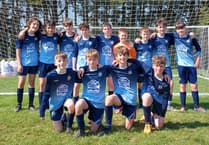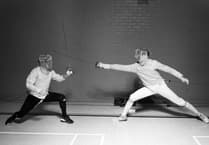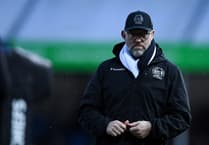THE slow process of rebuilding the country after the Great Depression began in the mid 1930’s. Whilst the country as a whole had suffered enormously, the impact was perhaps a little less severe in the South of England.
There were no major industries that relied on exports which had become expensive, this was in the main an area reliant upon agriculture and after all, everyone would need food so long as they could afford it, of course. However, one aspect of life that did not seem too badly affected was the sporting world, soccer, rugby, cricket etc., continued to be the outlet where, if only for a couple of hours each week, the troubles could be shelved.
Crediton Rugby Club had gone through a dip in fortunes during this period and, whilst the 1932-33 season had shown a modest improvement, nothing quite prepared even the most optimistic Crediton follower of what was to happen the following season.
The opening game meant a trip to Exmouth to play the Cockles Second XV, we had not enjoyed much success there over the years and as a Club, Exmouth had been one of the foremost in Devon.
However, we travelled back with an 11-3 victory courtesy of two tries and a conversion from Henry Mallett plus a Tom White try.
A great start to the season was about to get better when Withycombe came to Crediton and returned home after an 11-3 defeat, again Mallett was on the scoresheet with a try and there were tries also for J. Sutton and J. Webb with Archie Boddy converting one.
The third game in September brought Okehampton to Crediton and once again victory was ours, Alan B Stoyle, J. Webb and T. Church each scored a try with Mallett converting two in the 13-8 win.
However, in early October we were brought back to earth with a 7-9 defeat at Okehampton, all the points coming from A. Colwell with a try and a drop goal.
It seems the defeat was not without controversy and the “Crediton Chronicle” reporter at the time apologised for the shortness of his match report because somewhat unfortunately, he became embroiled in an argument with some Okehampton supporters, of course that would probably not be the last of such encounters.
Five more victories were rattled off in succession before a 0-6 defeat to Exeter Reserves. The weather interrupted games during early December but we reached the New Year with two more wins, a draw and a rather heavy defeat (3-41) against Exeter First XV. The draw was managed in a Boxing Day game away at Brixham of all places which seemed a long way to go for a Boxing Day fixture.
The New Year got off to the perfect start with victory over Tiverton 12-5, Stoyle with a couple of tries, Webb and Colwell one each.
After two successive defeats at Tamarians and Bideford, a further six wins were achieved, again Tiverton were beaten as were Ilfracombe twice, the second of which confirmed our semi-final place in the Devon Junior Cup where our opponents would be Withycombe.
The home draw for that semi-final did make us favourites but Withycombe had also had a good season and they held on for a 6-6 draw to earn a replay.
Colwell with a try and Mallett with a penalty accounted for our points. Sadly, the replay was one of those games where we had most of the possession and constantly attacked but were unable to break down the Withycombe defence.
For their part, Withies took advantage of a couple of our mistakes and scored twice for a 6-0 victory. Despite the disappointment of the Devon Junior Cup, it was an enormously successful season with 20 wins and two draws from the 28 games which was certainly the best return since the Club was formed.
Henry Mallett was the top scorer with 72 points from 12 tries, eight conversions, four penalties and two drop goals. Alan Stoyle with 11 tries and one conversion finished on 35 points and J. Webb with 10 tries and a drop goal completed his season with 34 points.
By modern standards, the conversion rate for tries was pretty poor, averaging just about 25 per cent. However, it should be borne in mind that the kickers did not have the advantage of the modern day ball, had they done so, then no doubt the rate would have improved drastically.
The 1933-34 season set the standard for a few seasons leading up to the outbreak of World War Two although results dipped the following year with only seven wins from 21 games, the success did come in the shape of a Second XV which played 14 games.
It certainly showed a mounting interest in the game, whether that was due to the success of the previous season is not known but it certainly must have helped. Sadly though, the 1934-35 season started with the news of the untimely death of William Howard at the age of 22. Howard had established himself as a regular First XV player and had also taken on the responsibility of Club Secretary. He was a huge loss to both the Club and the Town.
Tragedy struck the Club yet again at the beginning of the 1935-36 season this time with the death of Bertie John Labbett who was only 18 years-old and just embarking on his rugby career.
His family home was at Barnfield and he passed away in hospital where he was due to undergo and operation. Like many of the Labbett family who came before him and also those that came after him, he would no doubt have been a fine rugby player. Of course it is at times like these that sport and winning are brought into some perspective.
However, the season proceeded as per usual and was again successful with the First XV winning over half their games as did the Seconds.
By this time, the Second XV was becoming really well established and offering regular rugby throughout the season which would only strengthen the playing squad and provide real opportunities for players to fight for a first team place.
The consequence of that was simply a huge improvement in the standard of rugby that was played with the inevitable improvement of results. In 1936-37, the Club was beginning to reap the rewards as the First XV won 21 of the 27 games played with the Seconds winning 11 of their 20 games.
Players coming to the fore were Ted Powlesland, Den Heard, Ted Huddart, Albert Labbett, Cecil (Boxy) Strong along with some of the experienced players like Reg Boddy, Gifty Steer and Bill Lee, this would prove a powerful combination during the next couple of years.
The pinnacle was reached in the following two seasons, 1937-38 was remarkable, more games played than in any previous season, 31 in total for the First XV of which 24 were won, the first defeat did not come until January 29, 1938 when we lost 6-8 at Honiton, prior to that we had recorded 18 wins and a draw.
Results for the First team tailed off a bit with five wins and five defeats from the remaining games. In all 452 points were scored which, when it was only three points for a try was certainly an impressive return. The Second XV won eight and drew one of their 16 games and were proving a match for many other Club Second XVs.
The problems in Europe were mounting and it seemed that another war was imminent but it was still a year or so away and the 1938-39 season was completed and from a results perspective it almost matched the previous season with 20 wins and two draws from 30 games whilst the Second XV did not have as many games and won five and drew two of their 13 games.
The Club was establishing itself once again as one of the best of the Junior Clubs in the County. Certainly, we would not compete with Exeter, Plymouth, Torquay, Newton Abbot, Exmouth and Barnstaple at that time.
It is difficult to say what this team with such huge potential could have achieved had not six years of war interrupted their careers. In technical terms, the game had developed enormously between the wars, Clubs had coaches who studied the game much more than in the past.
Players were becoming more skilful and perhaps concentrating on positions more successfully. There was the feeling that the game was growing and certainly beginning to compete with soccer from the participant perspective if not with spectators.
Unfortunately, it would be another six years before we would see a try scored in Kirton colours.
Paul Harris





Comments
This article has no comments yet. Be the first to leave a comment.